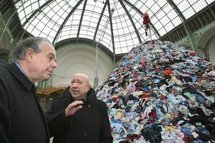
French Culture minister Frederic Mitterrand with French artist Christian Boltanski, near his installation
In icy cold and to the loud sound of a beating heart, the claw picks a few bits of discarded clothing from the pile that are left to flutter back down.
"It's like a metaphor on the hand of God, on fate, on our destinies," the 65-year-old artist told AFP. "It picks up clothes by chance, in the same way we fall by chance."
One of the country's foremost avant-garde artists, Boltanski was born in Paris in 1944 to a mother who was a writer and a doctor father from a Jewish family who lived more than a year hidden under the floorboards.
"The war and being Jewish are the two most important things that have happened in my life," he said in a recent interview.
But while death has long been of interest to Boltanski, he says his concern over the last decade is primarily to do with aging and his own demise.
"Death is covered up in contemporary western societies, old age is covered up," he added. "I'm seeking to ask questions here about fate and life and death."
To stage the show, which ends February 21, Boltanski gathered 30 tonnes of old clothes from a specialist recycling company, using some for the mound and others for a concentration camp-like display on the floor.
Carefully choosing hundreds of bits of clothing for their colour and cut, Boltanski laid them out on the ground in dozens of rectangles framed by metal poles and speakers blaring heartbeats.
In the last years Boltanski has recorded thousands of individual heartbeats and visitors to both the Grand Palais or a sister-show just outside Paris can record their heartbeats and take home a CD.
"He's interested in the traces we leave behind us," said Alexia Fabre, curator of the sister-show also opening this week at the Mac/Val museum in Vitry-sur-Seine and running until March 28.
The Grand Palais show is titled "Personnes" -- which in French means "Persons" but sounds like "Nobody" -- while the Mac/Val show is titled "Apres" or After, and is described by the artist as being infinitely "more joyous".
Held in what he imagines to be a post-death limbo, it features a dark world of big black cubes peopled by scarecrow-like creatures who ask the visitor: "Tell me, how did you die?", "Tell me, were you alone when it happened?", "Tell me, was it an accident?"
Asked if his dark message was really all about life, Boltanski laughed: "I'm a happy person who enjoys life. I hope everyone will find a message."
Said curator Fabre: "He's a humanist, who first and foremost I think believes in hope."
------------------------------------------------------------------------------------
"It's like a metaphor on the hand of God, on fate, on our destinies," the 65-year-old artist told AFP. "It picks up clothes by chance, in the same way we fall by chance."
One of the country's foremost avant-garde artists, Boltanski was born in Paris in 1944 to a mother who was a writer and a doctor father from a Jewish family who lived more than a year hidden under the floorboards.
"The war and being Jewish are the two most important things that have happened in my life," he said in a recent interview.
But while death has long been of interest to Boltanski, he says his concern over the last decade is primarily to do with aging and his own demise.
"Death is covered up in contemporary western societies, old age is covered up," he added. "I'm seeking to ask questions here about fate and life and death."
To stage the show, which ends February 21, Boltanski gathered 30 tonnes of old clothes from a specialist recycling company, using some for the mound and others for a concentration camp-like display on the floor.
Carefully choosing hundreds of bits of clothing for their colour and cut, Boltanski laid them out on the ground in dozens of rectangles framed by metal poles and speakers blaring heartbeats.
In the last years Boltanski has recorded thousands of individual heartbeats and visitors to both the Grand Palais or a sister-show just outside Paris can record their heartbeats and take home a CD.
"He's interested in the traces we leave behind us," said Alexia Fabre, curator of the sister-show also opening this week at the Mac/Val museum in Vitry-sur-Seine and running until March 28.
The Grand Palais show is titled "Personnes" -- which in French means "Persons" but sounds like "Nobody" -- while the Mac/Val show is titled "Apres" or After, and is described by the artist as being infinitely "more joyous".
Held in what he imagines to be a post-death limbo, it features a dark world of big black cubes peopled by scarecrow-like creatures who ask the visitor: "Tell me, how did you die?", "Tell me, were you alone when it happened?", "Tell me, was it an accident?"
Asked if his dark message was really all about life, Boltanski laughed: "I'm a happy person who enjoys life. I hope everyone will find a message."
Said curator Fabre: "He's a humanist, who first and foremost I think believes in hope."
------------------------------------------------------------------------------------









 Home
Home Politics
Politics









